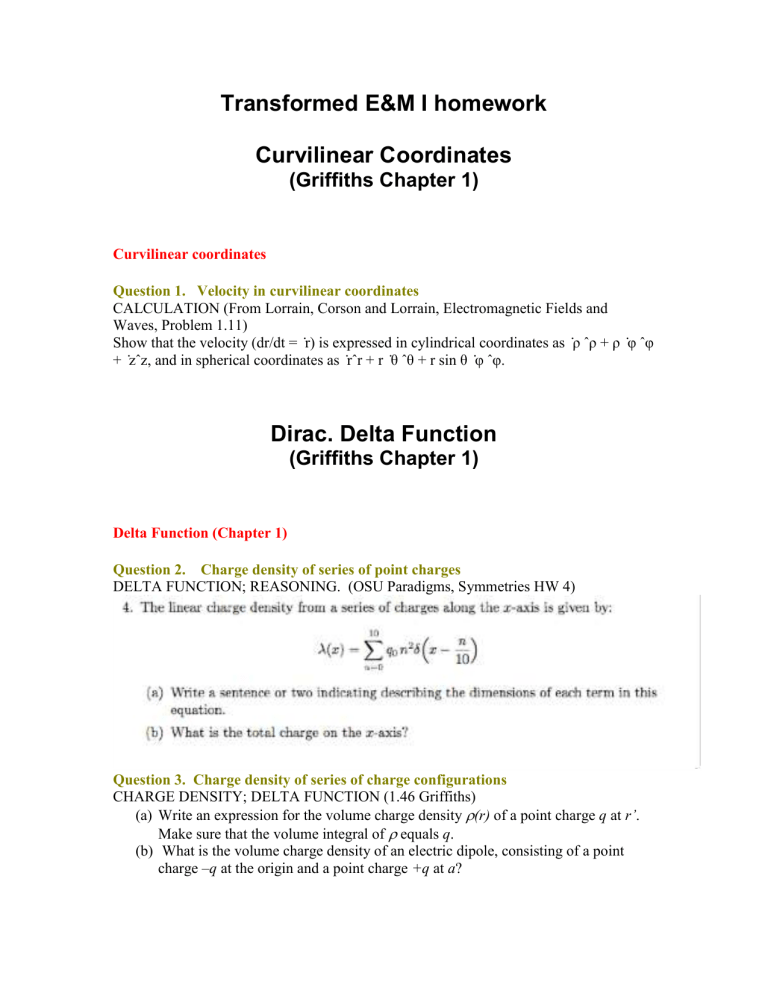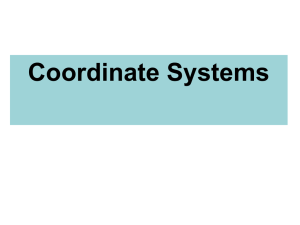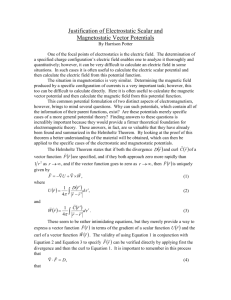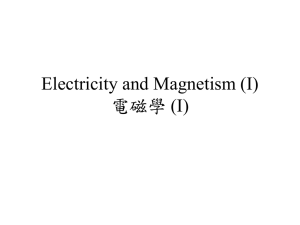E&M I Homework: Curvilinear Coordinates & Delta Functions

Transformed E&M I homework
Curvilinear Coordinates
(Griffiths Chapter 1)
Curvilinear coordinates
Question 1. Velocity in curvilinear coordinates
CALCULATION (From Lorrain, Corson and Lorrain, Electromagnetic Fields and
Waves, Problem 1.11)
Show that the velocity (dr/dt = ̇r) is expressed in cylindrical coordinates as ̇ρ ˆρ + ρ ̇φ ˆφ
+ ̇zˆz, and in spherical coordinates as ̇rˆr + r ̇θ ˆθ + r sin θ ̇φ ˆφ.
Dirac. Delta Function
(Griffiths Chapter 1)
Delta Function (Chapter 1)
Question 2. Charge density of series of point charges
DELTA FUNCTION; REASONING. (OSU Paradigms, Symmetries HW 4)
Question 3. Charge density of series of charge configurations
CHARGE DENSITY; DELTA FUNCTION (1.46 Griffiths)
(a) Write an expression for the volume charge density
(r) of a point charge q at r’ .
Make sure that the volume integral of
equals q .
(b) What is the volume charge density of an electric dipole, consisting of a point charge
–q
at the origin and a point charge +q at a ?
(c) What is the total volume charge density of a uniform, infinitesimally thin spherical shell of radius R and total charge Q centered at the origin? (Beware: the integral over all space must equal Q )
(d) We could add a question abot a line charge lambda. Write expression for rho(r) in cylindrical coordinates. Make sure that total charge = Q.
Question 4. Evaluate delta function integrals
DELTA FUNCTION (1.47 Griffiths)
Evaluate the following integrals:
(a)
all space
( r 2 r a a 2 ) 3 ( r a ) d
where a is a fixed vector and a is its magnitude.
(b)
(c)
V
r b
2
( r 4 r 2
3 (5 r ) d
where V is a cube of side 2, centered on the origin, and
( r c ) c 4 ) 3 ( r c ) d b 4 ˆ z
where V is a sphere of radius 6 about the origin, c
V
5 ˆ 3ˆ z
and c is its magnitude.
(d)
V r ( d r ) 3 ( e r ) d
where d =(1,2,3), e =(3,2,1) and V is a sphere of radius 1.5 centered at (2,2,2).
Question 5. Evaluate integral with divergence of 1/r 2
DELTA FUNCTION (1.48 Griffiths)
Evaluate the integral
J
V e r ( r
ˆ
2
) d
where V is a sphere of radius R centered at the origin, by two different methods, as in Ex 1.16. We could give this problem using just the function (r+1)
DELTA FUNCTION (modified 1.62 Griffiths)
Does this problem WORK in cylindrical coordinates? Make sure this isn’t too hard.
The electric field outside an infinite line that runs along the z-axis is equal to E
in cylindrical coordinates. Find the divergence of the E field. What is the formula for the charge density? [Hint 1: use cylindrical coordinates. Hint 2: your answer can’t be zero everywhere.] using front flyleaf? They have to get the factor of four pi using divergence them. Is there a 4 pi in cylindrical coordinates? Look at Eric Z’s lecture notes. Can we connect this to physics? What is the charge distribution required to create such an E field? How do we guide them through this a little bit?
Question 7. Delta Functions a) Calculate
1
1
| x c |
2
(2 x ) dx , with the constant c=3. b) Calculate
V
| r c |
2
3
(2 r ) d
, where the volume V is a sphere of radius 1, and the constant vector c =(3,4,0) c) Evaluate the integral
V
(1 e
r
) ( r
2
) d
where volume V is a sphere of radius R centered at the origin, by two different methods, as Griffiths does in Ex 1.16.
(One method, surely the easier one, is to use your knowledge of what
r
2
is.
r
The other is to use "integration by parts in 3-D", described in Griffiths section 1.3.6.
Don't forget that your purple crib sheet (inside flyleaf of Griffiths) tells you how to take the divergence of any arbitrary function in, e.g. spherical coordinates!)
The delta function, both 1-D and 3-D appears throughout this course. Physically, it represents a highly localized source (like a point charge), but as in part c, it will often appear "mathematically" when integrals arise involving Gauss’ law.
Assigned in SP08 (average score: a) 8.92, b) 8.92 c) 8.08)
Assigned in FA08
Instructor notes: Students were confused about 1b, in particular how to deal with the factor of “2” inside a 3-D delta function.
Question 8. Curl of vector field
DELTA, STOKES’, CURL (U WASHINGTON)
Divergence, Gradient, and Curl
(Griffiths Chapter 1)
Div, grad curl
Question 9. Sketch curves of isotherms
CH1 - GRADIENT (POTENTIAL)
Consider the two-dimensional scalar function
T ( x , y ) x 2 y 2 which we will imagine to be the temperature distribution in a two dimensional sheet. a.
Sketch the curves in the x-y plane for which constant temperature are called isotherms .
T 2,1,0, 1, 2
. These lines of b.
Using the fact that
T
T
is perpendicular to lines of constant T, sketch the
. directions of heart flow for a number of points (5 or so) on your graph.
Question 10. Derive the expression for curl
CURL (downloaded from Reed)
Derive the expression for the curl of a vector function coordinates. Not that you can write down
A A s
ˆ A
A z
ˆ
,
ˆ
and
in cylindrical
ˆ s
without any computations. You may do this two ways, either (a) repeat the derivation the way we did it for h
A
and h z
for cylindrical coordinates.
operators in curvilinear coordinates and compute
A
by identifying the functions h s
,
Question 11. Div, grad, curl on scalar
Which of the three operations (div, grad, or curl) can be sensibly operated on T?
For each which can:
a) give a formula for the result
b) explain in words how you would interpret the result.
c) is the result a vector or scalar?
Assigned in SP08
Assigned in FA08
Instructor notes: Given as math pre-test.
Question 12. Div, grad, curl on vector
Given an arbitrary vector function V (x,y,z) (e.g. the velocity of a flowing liquid)
Which of the three operations (div, grad, or curl) can be sensibly operated on V ?
For each which can:
a) give a formula for the result
b) explain in words how you would interpret the result.
c) is the result a vector or scalar?
Assigned in SP08
Assigned in FA08
Instructor notes: Given as math pre-test.
Question 13.Divergence and curl r
Consider an electric field E = c
(Please note the numerator is not r 2 r usual E field from a point charge at the origin, which would give c '
ˆ
: this is NOT the r 3
, right?!)
and the curl of this E field.
- Explicitly test your answer for the divergence by using the divergence theorem.
(Is there a delta function at the origin like there was for a point charge field, or not?)
- Explicitly test your answer for the curl by using the formula given in Griffiths problem
1.60b, page 56. b) What are the units of c? What charge distribution would you need to produce an E field like this? Describe it in words as well as formulas. (Is it physically realizable?)
Assigned in SP08 (average score: 11)
Assigned in FA08
Instructor notes: Many students thought that the units of C would be volts. Many students took this as the E field from a line of charge.
Question 14. Div and curl of vector fields
For each of the four vector fields sketched below....
Which of them have nonzero divergence somewhere? ______________
(If the divergence is nonzero only at isolated points, which point(s) would that be?)
Which of the following fields have nonzero curl somewhere? ___________________
(If the curl is nonzero only at isolated points, which point(s) would that be?)
(A brief explanation of your answers below each figure would be welcome)
A. B
C. D.
Assigned in SP08
Assigned in FA08
Instructor notes: Given as math pre-test.
Question 15. Sketch vector functions.
Make a quick sketch, in the x-y plane, of the following vector functions.
Plot enough different vectors to get a feeling for what this field looks like in the x-y plane.
(a) y ˆ
(b) r ˆ
(c)
(The symbol r here refers to the usual r in spherical coordinates) x
ˆ y x 2 y 2 x 2 y 2 y
Also just for this one (part c) - can you explain in words what this plot is showing?
Assigned in SP08
Assigned in FA08
Instructor notes: Given as math pre-test.
Question 16. Dot product
Given vectors A and B . ("Given" means you know the components, or alternatively, the length and angle of the vectors)
Define the dot product mathematically in two very different looking ways.
(Hint: one way should involve the components, the other, the length/angles)
Give a brief physical interpretation of what the dot product means or tells you (you can give a concrete example if you like)
Assigned in SP08
Assigned in FA08
Instructor notes: Given as math pre-test.
Question 17. Cross product
Define the vector cross product mathematically in two very different looking ways.
(Hint: one way should involve the components, the other, the length/angles)
Give a brief physical interpretation of what the cross product means or tells you (you can give a concrete example if you like)
Assigned in SP08
Assigned in FA08
Instructor notes: Given as math pre-test.
Question 18.Compute divergence, curl, grad
VECTOR CALCULUS PRACTICE
Compute gradients of a) exp( x )cos( y ) b)
Assigned in SP08
Assigned in FA08
Instructor notes: Given as math pre-test.
Compute divergence and curl of
Assigned in SP08
Assigned in FA08
Instructor notes: Given as math pre-test.
, Compute the curl of
.
Line, Surface, Volume Integrals
(Griffiths Chapter 1)
Line, surface, volume integrals
Question 19. Integral along a parabola
Evaluate the line integral along the parabola from the point (0,0) to the point (2,4).
Assigned SP08
Assigned FA08
Instructor notes: Given as math pre-test.
Vector Field (potential)
(Griffiths Chapter 1)
Vector identities (Chapter 1)
Question 20. Cute checks of fundamental theorems
DIVERGENCE THEOREM (Griffiths 1.59)
Is there meaning to this math?
Here are two cute checks of the fundamental theorems:
(a)
Combine Corollary 2 to the gradient theorem with Stokes’ theorem ( v T , in this case). Show that the result is consistent with what you already knew about second derivatives.
(b) Combine Corollary 2 to Stokes’ thereom with the divergence theorem. Show that this is consistent with what you already knew.
Question 21. Show various identities using vector identities
DIVERGENCE THEOREM (Griffiths 1.60)
Is there meaning to this math?
Although the gradient, divergence and curl theorems are the fundamental integral theorems of vector calculus, it is possible to derive a number of corollaries from them.
Show that:
(a)
( T ) d
Tda
[Hint: Let v = c T where c is a constant, in the divergence theorem;
V S use the product rules]
(b)
(c)
V
V
( v ) d
v da [Hint: Replace v by ( v X c ) in the divergence theorem]
[ T
S
2 U ( T ) ( U )] d
( T U ) da
[Hint: Let v =T
U in the divergence
S theorem]
(d)
( T 2 U U 2 T ) d
( T U U T ) da
[Comment: This is known as
Green’s
V S theorem ; it follows from (c) which is sometimes called
Green’s identity
]
(e)
T da
Tdl
[Hint: let v = c t in Stokes’ theorem]
S P
Question 22. Show vector identity
VECTOR CALCULUS IDENTITIES, PROOF (From Lorrain, Corson and Lorrain,
Electromagnetic Fields and Waves, Problem 1.6)
Show that
where A is the area of the closed surface bounding the volume V .
Hint: multiply each side by a constant vector and use calculus theorems.
Question 23. Check Stokes’ theorem with line integral
STOKES’ THEOREM (Downloaded from Reed)
Consider the vector field written in cylindrical coordinates:
A s 2
Sketch this vector function. Check Stokes’ theorem by calculating the line integral
A dl around a circle of radius 2 centered at the origin and oriented in the x-y plane. Compare
A
over the interior of the circle.
vector function F(r) = ˆφ where ˆφ is defined as conventional for spherical coordinates. a. Calculate the line integral where C is a circle of radius ρ in the xy plane, centered at the origin, and where the integral is evaluated with dl oriented counterclockwise. b. Calculate the surface integral where the surface H is a hemisphere that is above and bounded by the curve C used for part a. The surface integral is calculated with da oriented outward. c. Calculate the surface integral
where D is now the disk in the xy plane that is bounded by curve C , and da is oriented upward. d. Verify that Stokes’ theorem holds for both surfaces H and D









